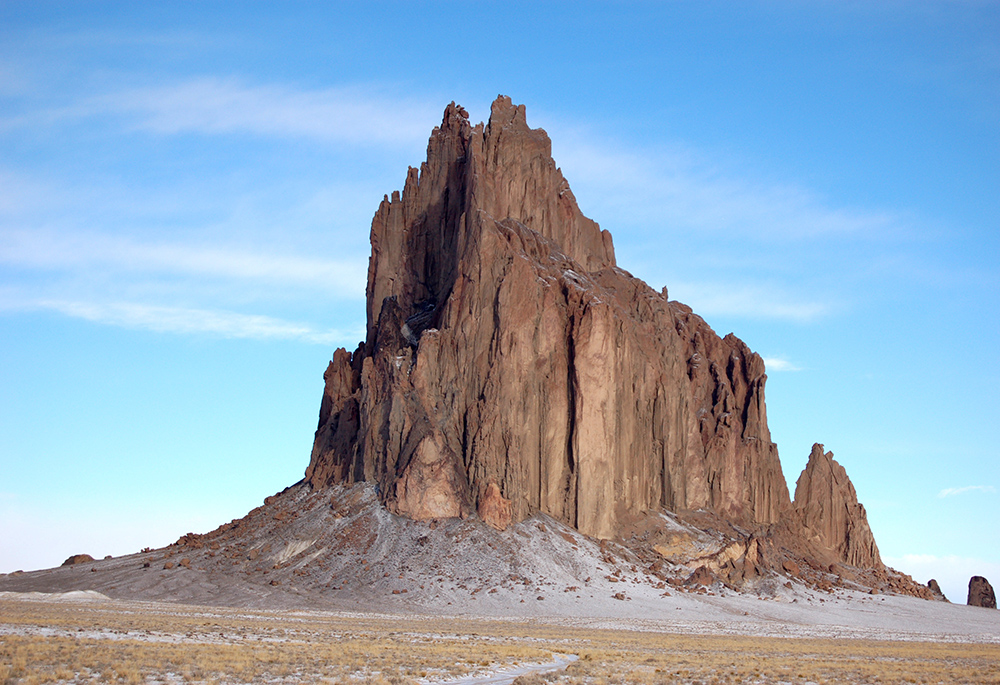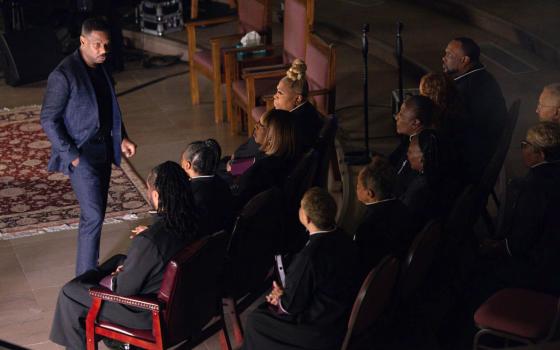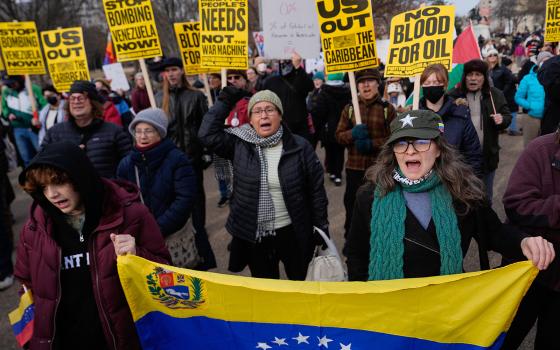
A photograph of Ship Rock, a geological formation, in Navajo Nation, New Mexico; in Navajo, it is called tsé bida'hi, "rock with wings." (Wikimedia Commons/Bowie Snodgrass, CC BY 2.0)
I came to New Mexico, the "Land of Enchantment" in 1987, after living the first 50 years of my life in the Midwest, east of the Rocky Mountains. Through these years, I have remained enchanted by the topography of the land, the dramatically different climate and the beauty of the people here in the Southwest. After having served in a variety of ministries from school superintendent and principal to several pastoral positions, I am currently serving as the ecclesial delegate for religious and academic director for our deacon and lay ministry programs. I do not live on the reservation or pueblo land but admire and support the sisters who do.
The diocese has a fascinating history that began in 1936 when Cardinal Eugenio Pacelli was traveling by plane over the southwestern United States. Noticing a huge swath of unpopulated and undeveloped land, he inquired what that area was. He was told it was the Navajo Nation. When he inquired what diocese it was in, he was told that although it was part of the Diocese of Santa Fe in eastern New Mexico, it extended westward into central Arizona.
When Pacelli became Pope Pius XII, he remembered this trip. Being concerned for the spiritual lives of the Native people, in 1939, he formed a new Diocese of Gallup, that stretched from north central New Mexico westward through northeastern Arizona, an area of 90,000 square miles. It was the diocese for Native Americans, even called the Indian Diocese in those days. He established it within the two states to conform to the contours of the Navajo Nation because he did not want the church to set up dividing lines for the Navajo people.
Later, in 1969, the Diocese of Phoenix was carved out of part of the Gallup Diocese, reducing Gallup's size to 55,000 square miles, but still including the northeastern quarter of Arizona. It is considered a mission diocese, defined as such because it does not have enough resources, financial or personnel, to support the liturgical and pastoral ministries for its people. Many of our programs are supported by generous Catholics in other dioceses of the United States.
A spiritual blessing of the diocese is having St. Katharine Drexel as "Mother" of the diocese because she was instrumental in bringing her own sisters and the Franciscan Friars from Cincinnati to minister to the people here.
Another blessing is the 50 sisters from 13 religious communities still ministering in the diocese in various capacities: pastoral life coordinators, teachers in our schools, catechists and directors of religious education, Rite of Christian Initiation of Adults, ministers in our Sacred Heart Retreat Center, our Diocesan Office for Social Justice, immigration ministry and service to the poor, and one contemplative community in prayer ministry.
Advertisement
I am inspired every day by the generous ministry of these women among the Native American people. Not only for their hands-on corporal and spiritual works of mercy, but the times too that they drive folks who have no means of transportation to hospital or doctor's appointments, or even haul water to their people's homes.
Many reservation parishes are without a resident priest, so sisters are the church's pastoral presence, the parish life coordinators. They help support and keep alive the strong faith of the Native American people. It is "Amazing Grace" to me to witness each year at the Rite of Election on the First Sunday of Lent the number of Native Americans coming into the church. They are usually the largest ethnic group seeking baptism.
Reservation life is poor here as on most reservations in our country and economically, Gallup is the poorest diocese in the U.S., home to seven tribes: Navajo, (the largest), Hopi, Zuni, Acoma, Laguna, Jicarilla Apache and White River Apache. Each tribe is a unique culture but all live with poverty. About 40% of the Navajo homes do not have running water and about 60% do not have electricity — and this is in the United States, the richest nation in the world.
In spite of the poverty, these tribal families exude pride in being "a Nation within a Nation." They are sovereign nations, having their own elections for governance and leadership, their own courts and justice systems and at the same time, are citizens of the United States who vote in federal elections. I also discovered that they have their own police department, which I personally experienced when going above the speed limit though the reservation and receiving a ticket from one of the Navajo officers.
Because it is a mission diocese, we sisters think of ourselves as missionaries, experiencing the truth of what has been said, that a true missionary does not bring God to the people, but rather finds God already there, and witnesses to the presence of the Holy One. Those of us who are here among the Native American people have learned more deeply an appreciation for God as Creator and for the holiness of nature. The people affirm again and again the teachings of Pope Francis. They know from experience the connection and interaction among all living creatures as part of their "religion." They thank plants and animals for contributing to their lives and well-being. They "do no harm" to any elements of nature.
Through them, I am still learning so much about God and life in these last 35 years. The two Native American women in my women's prayer group share so openly and beautifully about their faith, their challenges, their lives and who God is for them. For me, as a spiritual director, it is a sacred privilege to journey with others in their relationship with God, so it has been a sacred experience to live life in the presence of God in New Mexico, the Land of Enchantment. I have truly let myself be enchanted.






